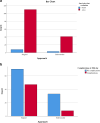Treatment of giant intracranial aneurysms: long-term outcomes in surgical versus endovascular management
- PMID: 36269463
- PMCID: PMC9663390
- DOI: 10.1007/s10143-022-01884-3
Treatment of giant intracranial aneurysms: long-term outcomes in surgical versus endovascular management
Abstract
Aneurysms with a major diameter > 25 mm are defined as giant intracranial aneurysms (GIAs). Different clinical, pathological, and radiological factors were revealed as playing a role in choosing the best strategy between surgical and endovascular approaches. Despite the improvement of both techniques, the efficacy and safety of these different management are still debated. We evaluated the differences in clinical and radiological outcomes of GIAs treated with surgical and endovascular techniques in a large retrospective mono-centric study. We compared aneurysm location, clinical, morphological features, treatment outcome, and complications on the ground of treatment technique. The final cohort consisted of 162 patients. All the patients were assigned on the ground of the type of eligible treatment: surgical (118 patients) and endovascular procedure (44 patients). The different treatment strategies were made through a multidisciplinary selection whereas clinical parameters, location, and morphologic features of the aneurysm were considered. The surgical group manifested a greater reduction in performance levels and neurological status in the post-operative phases than the endovascular group (p < 0.01) with a higher incidence of complications (p = 0.012) in contrast to a lower recurrence rate (p > 0.01). There is no significant difference in post-operative mortality and survival between surgical and endovascular groups. The surgical group manifested a higher incidence of complications after treatment. The endovascular group has a better post-operative outcome, but a higher risk of recurrence and the necessity of further treatment.
Keywords: Brain aneurysm; Coiling; Endovascular; Giant intracranial aneurysm; Neurosurgery.
© 2022. The Author(s).
Conflict of interest statement
The authors declare no competing interests.
Figures




References
MeSH terms
LinkOut - more resources
Full Text Sources
Medical

